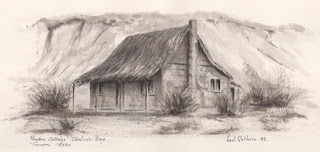On the shore's of Lake Tekapo
 |
| Church of the Good Shepherd |
It
is not too difficult to understand why so many visitors feel drawn to this
little church, located on the southern shore of Lake Tekapo, deep in the
Mackenzie Country.
Inside, one can stand in
the aisle and absorb the breath taking view, framed through a north-facing
window. In the foreground, sunlight
sparkles on the crest of small white tops, whipped up by a sudden gust of wind
across the lake. In the distance, rugged
peaks of the Southern Alps , expose a fresh
coat of snow, silhouetted against a backdrop of descending storm clouds.
It was Reverend
W. Davies, Vicar of the Mackenzie Parish, up until 1935, who was the instigator
of this church. It was a chance remark I
believe, made over a cup of tea after a Sunday Church
“Why can’t we
build a church at Tekapo,” asked the vicar of one of his parishioners, “we have
most of the material to hand?” With a little humour he continued, “even if
we can’t afford furnishings, there are plenty of kerosene boxes around, they’ll
do to sit on for a start.”
I know the
enthusiasm of those folk who choose to live in the Mackenzie Country and that
church, to all intentions, would have been almost completed, bar the finishing
touches by the time afternoon tea was over.
However, there
was a lot to do and a lot of people to see.
Reverend Davis, the bit firmly clasped between his teeth, his ebullience
became infectious throughout the whole of the Mackenzie. It was due to his determination the initial
building committee was up and running so soon.
Mrs Norman Hope,
who at the time lived at the Grampians sheep station, an artist of some
considerable note and member of that inaugural committee, fashioned a model of
the proposed church from a block of Plasticine.
That design, with full
committee approval, went to the Christchurch
Fred Trott, who
in conjunction with his wife, owned the Tekapo Hotel, or in the absence of a
liquor licence at that time, it was officially known as Tekapo House. Fred who had been a builder working in
Geraldine prior taking over Tekapo House, submitted his tender for the
construction, which was duly accepted.
Dr Campbell
West-Watson, Bishop of Christchurch, blessed the proposed site for this new
church during a special open air Church Service, held on 15th January 1935.
That service was
conducted in the presence of His Royal Highness Prince Henry, Duke of
Gloucester, and it was he who laid the foundation stone.
Jack Miller, Les
Loomes and Bill Blissett performed all stonework on this building, with the
material collected from around the foreshore by a band of enthusiastic
volunteers.
The roof construction is of
New Zealand Rimu timber, milled on the West Coast of the South
Island and hand hewn on site prior to soaking in a preservative
solution of linseed oil and tar.
The architect
also designed the pews and communion rail, along with the vicar’s prayer desk
and seat. Apart from the pews, which
were built on the site by Doug Rodman, while Harry Foden, in his factory at
Fairlie, constructed the remainder of the furniture?
Large blocks of
Oamaru stone, previously transported to Tekapo by horse and dray, were hand
crafted into the font and altar. The
font was designed and carved in the memory of those shepherds, musterers and
station hands that pioneered the Mackenzie, depicting their determination and
fortitude, in the face of what must have seemed insurmountable odds.
The vicar’s
prayer desk and seat, were presented in memory of those women pioneers of the
Mackenzie, whose courage at the side of their menfolk, opened the Mackenzie up
to what it has become today.
This little
church typifies the rugged character and the harsh surroundings of the
Mackenzie and commemorates those who have gone before.
As a matter of interest, the name, ‘Church
of the Good Shepherd’, comes from the Alter, where a dynamic and powerful
carving, portrays Jesus Christ as the Son of God, Good Shepherd of the Gospels


Nice post.
ReplyDeletehttps://pbase.com/atulsen/profile